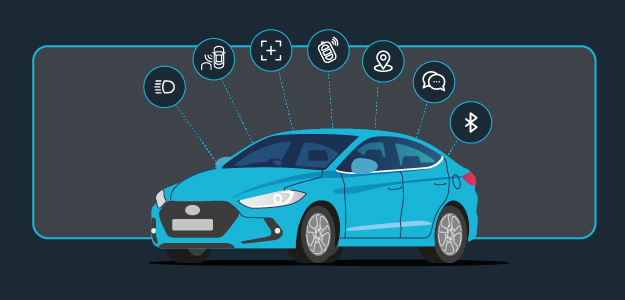

Editors note: This 3-part series of posts discusses the role of oscilloscopes in the automotive industry. Here’s the lineup:
Part 1: Bringing Portability and Power to the Automotive Industry with the 2 Series MSO
Part 2: Automotive Customers Find Improved Access and Collaboration in 2 Series MSO Remote Capabilities
Part 3: Debugging Automotive Serial Buses with the 2 Series Mixed Signal Oscilloscope
Embedded systems applications are appearing in a multitude of industries and in all kinds of electronic products that the average consumer uses every day, from cars and trucks to dishwashers, children’s toys and mobiles phoness. The embedded systems market is expected to grow to $116.2 billion by 2025 in large part due to the automotive industry, which has seen a steep rise in the demand for advanced driver-assistance systems and electric and hybrid vehicles.
The more autonomous cars become, the more systems there are in every vehicle design, requiring comprehensive testing with sophisticated tools to ensure clear, real-time communications among the many important subsystems that keep drivers and their loved ones safe on the road.

A Shifting Automotive Landscape
As we discussed in part two of this series, today’s cars can include as many as 100 different electronic control units (ECUs) designed to perform different tasks, from basic utility functions to operating entertainment, navigation or airbag systems. Most vehicle designs use serial data buses, which help eliminate the need for multiple sensors and wiring, to communicate among these ECUs and between ECUs and sensors, actuators and displays.

Automotive engineers typically have extensive experience using an automotive oscilloscope, which can decode and trigger on automotive serial buses such as CAN, CAN FD, LIN, and SENT, among others. These bus protocols are designed to be robust, but communications can still be impacted by issues like noise and board layout and lead to excessive bus errors and lockups. Engineers need to be able to identify and debug the issue quickly, whether the car is sitting in the lab or being tested on the track.
Advanced Measurement Tools for an Industry on the Move
Most modern oscilloscopes are equipped with protocol decoding and can be used to see both the decoded bus traffic, as well as the signal quality, making them the best tool for troubleshooting and system-level debugging in the lab. The recently unveiled Tektronix 2 Series Mixed Signal Oscilloscope (MSO) comes equipped with protocol decode and triggering capabilities that can trace the flow of activity through a system by observing the traffic on one or more serial buses. The 2 Series MSO can decode and trigger on CAN, CAN FD, LIN and SENT automotive buses and is small enough to be taken wherever an engineer might be working, making field debug accessible, precise, and repeatable.
An Automotive Engineer’s Workflow
The infographic below shows how an automotive engineer might use the 2 Series MSO to unlock new insights and decode automotive signals in the field.

This concludes our journey detailing the many ways the new 2 Series MSO can directly benefit our automotive customers and beyond, and we hope you’ve enjoyed the ride!
Learn more about the 2 Series MSO and how it can benefit your automotive team. Read more about the automotive bench solution featuring the 2 Series MSO.


